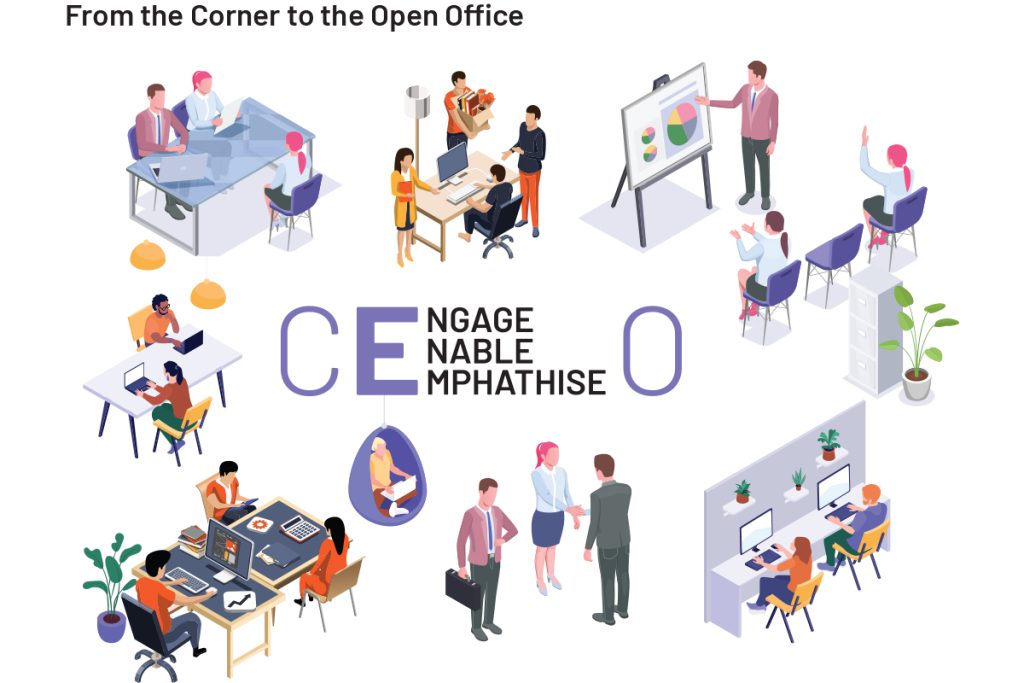The traditional Corner Office symbolizes corporate power, but today’s CEOs must step out to engage, enable, and empathize with their teams in an ever-changing business landscape
Words by Rohit Pathak
The Corner Office has been an enigma in the corporate world for decades. It is a much sought-after “Room” for leaders, signalling the pinnacle of one’s professional career—the ultimate seat of power and influence in the company. Occupying the Corner Office and getting there faster than others is an ambition (hidden or explicit) for most professionals. And to be honest, when I became the CEO of a leading manufacturing company before turning 40, it did give me the kicks of a major achievement unlocked!
Over the years, the designation of the Chief Executive Officer has been associated with three main roles: setting the vision, giving direction to the teams, and making decisions (on business and people). But more importantly, being at the Top of the Pyramid, the role has been attributed to some strong stereotypes that subconsciously influence the incumbents’ behaviour as well as expectations others have from the person – Distant & Inaccessible, a Person to be Feared, a Taskmaster and a Serious person not to have a casual conversation with!
However, Leadership, whether in the corporate world or in the society, is contextual. The Cultural Context, the broader Economic Environment, the Industry Dynamics and the Company situation play a key role in what kind of a Leader is needed and will succeed in the Corner Office!
In the era of globalisation and rapid economic growth the world saw post the World Wars, companies focused on Execution (and repeating what worked), Building Scale, Efficiency and Functional Excellence. The larger workforce sought direction and someone to tell them what to do. In this context, the Hierarchical/Authoritarian style of Leadership (perhaps inspired by the defence forces that were the genesis of many of the management paradigms) worked well and, over time, became the prevalent style of many CEOs.
However, today’s workforce comes from an environment of abundance (having a choice of what to do with their lives and strong opinions about what kind of work they want to do). At the same time, we are in a VUCA world where business and societal contexts are changing rapidly and forcing companies to be Agile and Adaptive yet still build Scale, be Sustainable yet deliver High Growth, and be Inclusive yet Align and respond fast.

In this context, we need to flip the hierarchy from thinking of the CEO as the head of the organization to one at the bottom, supporting the entire organisation, and rethink how the CEO leads the organisation. The Corner Office needs to change how it operates and what it represents. Today’s workforce is not a Resource but needs to be treated as Resourceful. The CEO does not sit in a corner office with several check posts before an employee can reach it but is instead an approachable entity, accessible to all, irrespective of their seniority. You go to the CEO not to seek a decision but guidance on how to decide, and sometimes just for a hearing!
The Chief Executive role is no longer about developing the strategy or even executing the strategy, or solving problems that come along the way. The role is about getting the strategy developed, empowering teams to execute it and getting the problems solved. Instead of a being a distant, feared and authoritarian leader, the CEO of today needs to be a person who:
- has a vision but more importantly has a Clear Purpose (for self and the organisation)
- can set the broad direction and create an environment so that the Team Can Decide and Drive the right course of action (vs give orders/instructions)
- has the Clarity of Thought to prioritise and decide under ambiguity and often without 100% information/analysis (and not overload the teams with pointless analysis)
- is able to Engage, Enable and Empathise with the team instead of being obsessed with ruthless execution and delivery.
Over the past few years, I have experimented with and refined my style of leadership, learning from observing other inspiring leaders and employees, as well as from my failures and successes. I must confess, though, that these learnings come more from my experience in the manufacturing and industrial space, and hence, nuances of the service or startup ecosystem may need further refinement in the approach.
While there is still a lot for me to learn, I have come to realise that the “E” in the coveted CEO role cannot be “Executive” in today’s day and age. It needs to be a lot more meaningful and expansive. The “E” in the CEO role needs to be:
- Engaging – someone who is approachable to all, who listens to and builds on the thoughts of the team, and who connects all to a higher purpose for the organisation
- Enabling – someone who creates a culture/environment for a team to decide/lead and take ownership of the organisation’s goals
- Empathising – someone who understands individual team members (their strengths, development areas & personal challenges) and helps them deliver beyond their perceived potential.
While growing up in our professional journeys, many of us aspired to get to that coveted Corner Office. Today, as some of us get into this role, I think it is important for us to redefine this role to lead differently and Uncorner the CEO office to make it an accessible and welcoming hub that helps connect the entire organisation efficiently to Operate as One!
As is often said, Leadership is not about leading people. Leadership is about having the courage to do the right thing. Followership comes automatically as you do that.
Rohit Pathak is CEO of the Copper Business at Hindalco Industries Limited.


